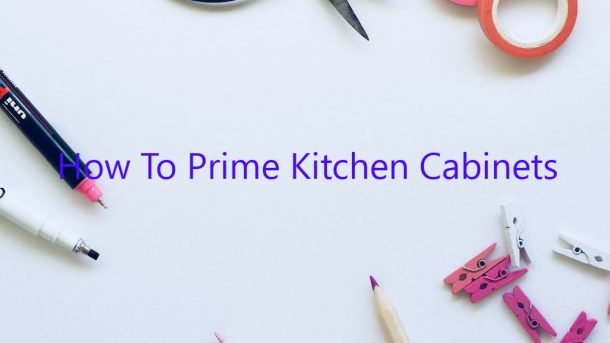Kitchen cabinets play a big role in the overall look and feel of your kitchen. They can make or break the design of the room, so it’s important to make sure they are properly primed before painting.
There are a few different ways to prime kitchen cabinets, but the most common is to use a paint primer. This will help the paint adhere to the surface of the cabinet and will also help to cover any existing stains or blemishes.
Before priming, it’s important to clean the cabinets. This can be done with a degreaser or a household cleaner. Once the cabinets are clean, you can begin priming.
If you are using a spray primer, it’s important to make sure the surface is completely covered. Be sure to also get into the nooks and crannies, and to cover the edges of the cabinet.
If you are using a brush, make sure the primer is well-mixed and then begin applying it in a thin coat. Be sure to brush in the direction of the wood grain, and to avoid any build-up.
Once the primer is dry, you can begin painting the cabinets. Again, it’s important to use a paint primer to help the paint adhere to the surface. Be sure to also paint the edges of the cabinet and to avoid any build-up.
Allow the paint to dry completely, and then re-apply a second coat. Once the paint is dry, you can apply a sealant to protect the paint from scratches and fading.
By following these simple steps, you can make sure your kitchen cabinets look great for years to come!
Contents
Do I need to prime my kitchen cabinets before painting?
Do I need to prime my kitchen cabinets before painting?
If you are planning on painting your kitchen cabinets, you may be wondering if you need to prime them first. The answer to this question depends on the type of paint you plan to use.
If you are using a latex paint, you do not need to prime your cabinets. However, if you are using a oil-based paint, you will need to prime them first. This is because latex paint is not as durable as oil-based paint, and it may not stick to the surface of your cabinets properly without primer.
If you are using a paint with a high sheen, such as a gloss or semi-gloss paint, you will also need to prime your cabinets. This is because these types of paint are more likely to show any imperfections in the surface of your cabinets.
If you are not sure whether or not you need to prime your cabinets, it is best to err on the side of caution and prime them anyway. This will help to ensure that your paint job looks good and lasts for a long time.
What kind of primer do I use on kitchen cabinets?
When it comes to priming your kitchen cabinets, there are a few different things to consider. The first decision you’ll need to make is what type of primer to use. You have a few different options, but the most common are oil-based and latex-based primers.
Oil-based primers are best for cabinets that have been stained or are made from a porous material, like wood. Latex-based primers are more versatile and can be used on both stained and un-stained cabinets. They’re also better for cabinets that are made from a non-porous material, like plastic or metal.
Once you’ve decided on the type of primer to use, the next step is to figure out the right primer color. Primer comes in a variety of colors, so you’ll need to choose the one that best matches the finish of your cabinets. If you’re not sure what color to choose, it’s best to go with a neutral color like white or beige.
Once you’ve got the primer chosen, it’s time to start painting! First, remove all of the cabinet doors and hardware. Then, lightly sand the surface of the cabinets to remove any debris or dust. Next, apply a coat of primer to the cabinets and let it dry for the recommended amount of time. Once the primer is dry, apply a coat of paint in the desired color. Let the paint dry completely, then reattach the cabinet doors and hardware.
Is priming kitchen cabinets necessary?
When you are painting your kitchen cabinets, do you need to prime them first? This is a question that many homeowners have. The answer is it depends.
If your cabinets are made of solid wood, then you will need to prime them before you paint them. This is because the paint will not adhere well to the wood without a primer. However, if your cabinets are made of a veneer or a laminate, then you do not need to prime them.
If you are unsure whether you need to prime your cabinets or not, it is best to err on the side of caution and prime them. This will help ensure that the paint will adhere well and that the cabinets will look their best.
How do you prime kitchen cabinets to paint?
There are two ways that you can prime kitchen cabinets to paint – with a brush or a roller.
If you are using a brush, you will need to apply a thin coat of primer to the surface of the cabinet and then let it dry before applying a second coat. Make sure that you are careful to get into all of the nooks and crannies, as this will ensure that the paint will adhere properly.
If you are using a roller, you will need to apply a thicker coat of primer to the surface of the cabinet. Be sure to roll the primer in the same direction as the grain of the wood, and to avoid going over the same spot twice.
How long after priming cabinets can I paint?
There’s no one-size-fits-all answer to this question, as the amount of time you’ll need to wait before you can paint your cabinets will vary depending on the type of primer you use. However, most primers require at least 24 hours to dry completely, so you’ll likely need to wait at least that long before you can start painting.
If you’re using a water-based primer, you may be able to start painting within a few hours of applying it, but it’s still a good idea to wait 24 hours to make sure the primer is fully dry. Oil-based primers usually take a bit longer to dry, so you’ll likely need to wait 48 hours before you start painting.
In any case, it’s always a good idea to test a small area of your cabinet to make sure the primer has dried completely before you start painting. If the paint starts to peel or chip off, it’s likely because the primer wasn’t fully dry when you started painting.
How many coats of primer do you need on cabinets?
Priming your cabinets is an important step in creating a durable finish. How many coats of primer you need will depend on the surface condition of your cabinets and the type of primer you are using.
If your cabinets are in good condition and have a smooth surface, one coat of primer may be enough. If your cabinets have any rough spots or bumps, you will need to apply two or more coats of primer to ensure a smooth, even finish.
When choosing a primer, be sure to select one that is designed for use on wood. Some primers are specifically made for cabinets, while others are designed for general use.
If you are using a primer that is not specifically designed for cabinets, be sure to test it on a small area first to make sure it will provide the desired results.
Once you have applied the primer, allow it to dry completely before moving on to the next step.
How many coats of primer do I need on cabinets?
When painting cabinets, you will need to use primer to cover the surface and create a smooth base for the paint to adhere to. How many coats of primer you need will depend on the condition of the cabinets and the type of primer you are using.
If the cabinets are in good condition and have a smooth surface, you may only need one coat of primer. If the surface is rough, you may need two or three coats of primer. If the cabinets are very old or damaged, you may need to sand the surface before priming it.
The type of primer you use will also affect how many coats you need. If you are using a latex primer, you may only need one coat. If you are using an oil-based primer, you may need two or three coats.
Make sure to wait for the primer to dry completely before painting the cabinets.




